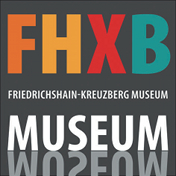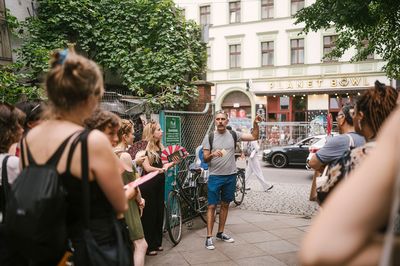
Long Week of Neighbourhood History: city tours in Kreuzberg and Friedrichshain on 25 May, 29 May and 1 June
25 May | 29 May | 1 June
The “Long Week of Neighborhood History” invites you to discover unknown and unusual stories of Berlin on city tours, talks, bike tours and audio walks under this year's theme “City in Transition”. As part of this event, the FHXB Friedrichshain-Kreuzberg Museum is offering the following city tours:
(All tours are in German)
City tour 1:
Migrant self-organisation against racism and fascism
Saturday, 25 May, 1 pm
Meeting point: Garden of the FHXB Museum
On the city tour at Kottbusser Tor, the junction point of Kreuzberg's migration history since the 1960s, we will explore places of social dynamics of migrant self-organisation and resistance against racism and fascism together. A journey through time and space that brings us closer to the power of solidarity and political engagement in Kreuzberg.
Registration required
Contact: veranstaltungenfhxb-museum.REMOVE-THIS.de
City tour 2: 17 June 1953 in Friedrichshain
Wednesday, 29 May, 5 pm
Meeting point: Frankfurter Tor at the steps in front of the "Brewdog" pub
71 years ago, on 17 June, there was a nationwide popular uprising in the GDR. There are numerous biographical and geographical references in the Friedrichshain district around the former Stalinallee that can be discovered on this city tour.
Registration required
Contact: Tom-Aaron Aschke, tomaaron.aschkegmail.REMOVE-THIS.com
City tour 3: Power station, piano plague and coal mountain. A consumer and environmental history of Kreuzberg
Saturday, 1 June, 1:30 pm
Meeting point: Ohlauer Str./Paul-Lincke-Ufer
Environmental history is dedicated to the many interactions between humans and the environment. The fight against microbes will be just as much a part of the city tour as the change in household management and our role as consumers. We will also follow the many struggles of Berliners for public parks, cycle paths and an environment worth living in.
Registration required
Zusätzlicher Termin für die Führung durch das Schinkel-Denkmal am 9. September
6. September | 17:00 Uhr | Viktoriapark

Aufgrund der großen Nachfrage wird ein zusätzlicher Termin am 06.09.2024 für die Führung durch das Schinkel-Denkmal auf dem Kreuzberg angeboten.
Die Führung dauert ca. 2 Stunden und kostet 10,00 € pro Person. Wegen der begrenzten Teilnehmer:innenzahl ist es notwendig, Karten vorab im Kontor des FHXB Museums zu erwerben.
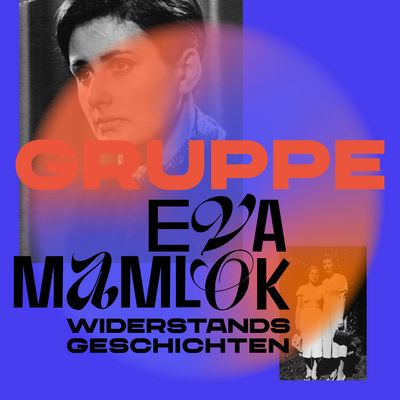
Eva Mamlok Group – Histories of Resistance
Duration: 14 June – 22 September 2024 (opening on 13 June, 6:30 pm)
In the early 1930s, there were already brave young women in Berlin’s Kreuzberg district standing up to Nazism. One of them was Eva Mamlok, a Jewish teenager who performed everyday acts of resistance against the Nazi regime – first alone, and then alongside other young women. They formed networks, distributed leaflets, wrote slogans on walls, and organized an underground library.
As Jews, they were persecuted and enslaved. For their antifascist activism, they were arrested and deported. Yet even in the most terrible circumstances, they never stopped resisting.
Until now their story has barely been told, partly because very few sources and documents exist – besides the testimonies from Inge Gerson-Berner, the only member of the group who survived the Holocaust. This exhibition will present an extensive, never-before-seen body of scholarship compiled by a network of citizen researchers. It brings together historical documents, photographs, and eyewitness accounts that invite visitors to revisit the past while exposing the gaps and holes in the record. It carves out space for questions and debate and seeks to raise awareness of the crucial role women played in the resistance against Nazi tyranny.

Cross-border protest. The 17 June 1953 in Friedrichshain-Kreuzberg
17 june | 6 pm | Studio theatre in the Alte Feuerwache
The "popular uprising of 17 June 1953" in the GDR is a central historical event in recent German history and, above all, in the history of Berlin. The former Stalinallee (today: Karl-Marx-Allee) was a central place of protest in today's Friedrichshain-Kreuzberg district: workers from various Friedrichshain companies around Warschauer Straße joined the strikes; on the Oberbaumbrücke, young people discovered the chairman of the East German CDU, Otto Nuschke, in his official car and rolled him across the sector border into West Berlin's Kreuzberg district.
The learning and research project "Youth in Political Protest" at the Berlin-Hohenschönhausen Memorial explores the protest participation of young people during the "Popular Uprising of 17 June 1953". Using biographies of young protest participants, the project explores the causes, processes and consequences of participation in the uprising and aims to convey the complexity of the protest events.
At the event in cooperation with the FHXB Friedrichshain-Kreuzberg Museum, staff from the Berlin-Hohenschönhausen memorial centre will provide an insight into the project. Using individual biographies, they will trace the protest events of 17 June 1953 in the district and discuss the links to neighbouring West Berlin's Kreuzberg district. The event will also discuss how the use of images shapes the public memory of 17 June 1953. Last but not least, dominant narratives and historical images of the event will be scrutinised, particularly with regard to age and gender.
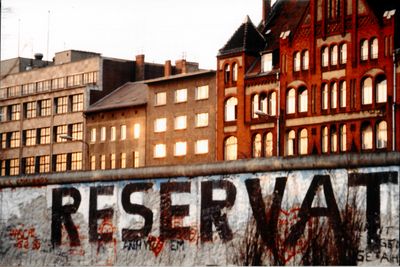
Kiezgespräch - Life at and with the Berlin Wall
20 June | 6 pm | FHXB Museum
35 years after the fall of the Wall, Friedrichshain and Kreuzberg belong together as a matter of course. From 1961 to 1989, however, the neighbourhoods were separated by the Wall and border fortifications. How did the neighbourhoods develop during the division? How did people in Friedrichshain and Kreuzberg view the division of the city? And what did the fall of the Berlin Wall in 1989 mean for the local people? The Berlin Commissioner for the Reappraisal of the SED Dictatorship (BAB) explores these and other questions in its event series "My neighbourhood. History(s) of Divided Berlin". The series will stop off in Kreuzberg in June.
On 20 June 2024, 6 pm, a neighbourhood discussion with historian Anna von Arnim-Rosenthal and contemporary witnesses Bettina Rathenow and Sanem Kleff will take place at the museum. Bettina Rathenow was a co-founder of the opposition group Women for Peace in the GDR and a participant in the Round Table in Friedrichshain in 1989/90. Sanem Kleff, a teacher of Turkish origin, worked at a secondary school in Kreuzberg from 1981. Today she heads the "School without Racism - School with Courage" project. The discussion will be moderated by BAB speaker Dr Philipp Schultheiß.
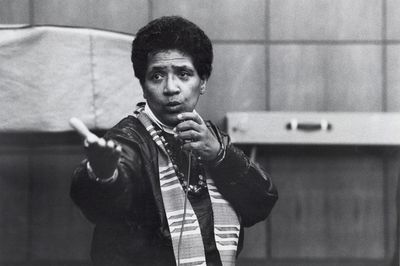
Inauguration of Audre Lorde Street and a memorial to Audre Lorde
28 June | 5 - 7 pm | Intersection Audre-Lorde-Straße/Muskauer Straße
Feminist, campaigner and poet Audre Geraldine Lorde (1934-1992) had a significant influence on the Black women's movement worldwide with her work against homophobia, sexism and racism. Between 1984 and 1992, she often spent time in West Berlin, including in Kreuzberg. Here she gave readings and lectures, called for a fight against racism and encouraged Black women to make their own history visible.
In February 2019, the district parliament of Friedrichshain-Kreuzberg decided to name a street after Audre Lorde. Based on a public consultation, it chose the northern section of Manteuffelstraße. Now there is officially an Audre Lorde street in Kreuzberg.
With speeches by Clara Herrmann (district mayor of Friedrichshain-Kreuzberg), Werner Heck (head of the Friedrichshain-Kreuzberg district council), Katharina Oguntoye, Marion Kraft, Dagmar Schultz, Tahir Della & Jasmin Eding
With music and artistic contributions by 3 Women, Joliba Choir & Lahya Aukongo
An event organised by FHXB Museum & Art Planner
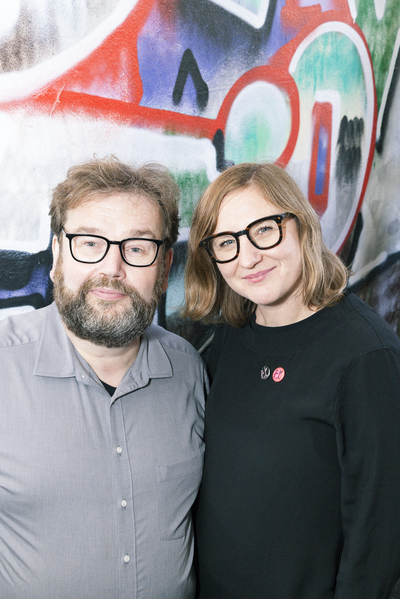
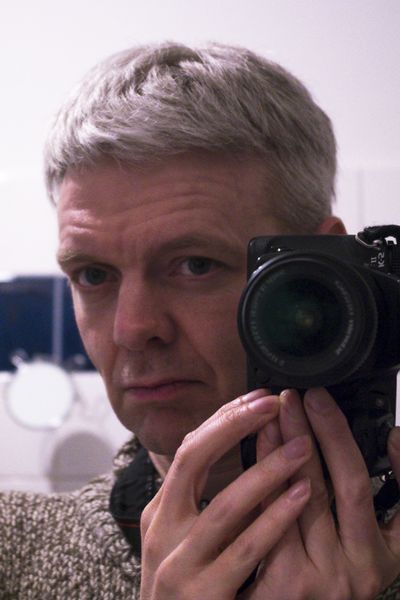
Long Book Night in Oranienstraße
29 June | 5:30 – 7:45 | FHXB Museum
Life in resistance: Franziska zu Reventlow, Erich Mühsam, Olga Benario, Fritz Oerter
5:30 – 6:30 pm
In the context of the exhibition "Gruppe Eva Mamlok - Widerstandsgeschichten" (14 June - 22 September 2024), which focuses on the resistance of young Jewish anti-fascists in Berlin-Kreuzberg, Kristine Listau and Jörg Sundermeier from Verbrecher Verlag will present various texts by anti-fascist authors such as Olga Benario and Erich Mühsam.
https://www.verbrecherverlag.de/
Milly Witkop and Rudolf Rocker - An anarchist dream couple from a Yiddish perspective
by Arndt Beck
7:00 – 7:45 pm
Milly Witkop and Rudolf Rocker met as politically active anarchists in London in 1895, were both imprisoned during the war, spent the Weimar years together in Berlin and fled to the USA in 1933, where they lived until Milly's death in 1955. The Kreuzberg artist and co-founder of yiddish.berlin Arndt Beck reads excerpts from the Yiddish press and highlights the work of two unusual people.
Event as part of the long book night. You can find the complete programme here.
Venue and organiser:
FHXB Friedrichshain-Kreuzberg Museum, Adalbertstraße 95a,
www.fhxb-museum.de
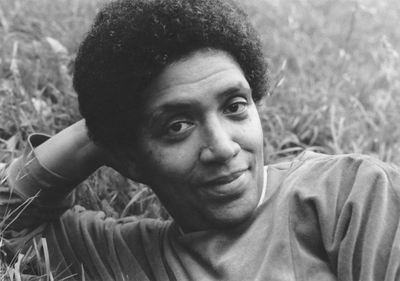
Audre Lorde – The Berlin Years
extended until 08 September | 6pm | FHXB Museum
The African-American lesbian poet and activist Audre Geraldine Lorde (1934-1992) had a significant influence on the Black women's movement worldwide with her work against homophobia, sexism and racism. Audre Lorde often spent time in West Berlin between 1984 and 1992. Here she gave readings and lectures, called for a fight against racism and encouraged Black women to make their own history visible.
To mark the renaming of a street after Audre Lorde, the FHXB Museum is showing the photo exhibition "Audre Lorde - The Berlin Years". This exhibition was originally shown in 2014-2015 at the John F. Kennedy Institute for North American Studies at Freie Universität Berlin, where Audre Lorde held a visiting professorship in 1984. The portraits by Dagmar Schultz show Audre Lorde in various places in and outside Berlin, both in private moments and in her socio-political commitment.
Intervention in the permanent exhibition "ortsgespräche - ferngespräche - ortsgeschichten"
Duration: Extended until 8 September 2024
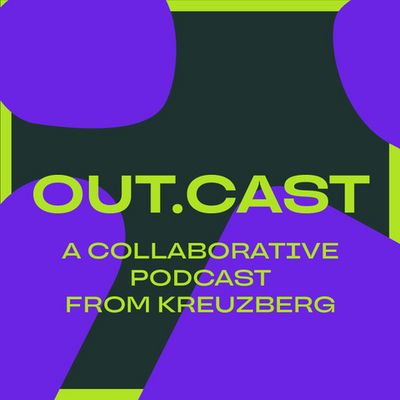
OUT.CAST
The new podcast out.cast can now be heard (almost) everywhere there are podcasts!
Over the past two months, a group of activists and artists have been working intensively on concepts, research, interviews and editing techniques, supported by several workshops organised by studio lärm at the FHXB Museum. The result is five stand-alone yet interconnected audio pieces with stories, sounds and original sounds that tell of dreams and struggles.
--> out.cast bei allen Plattformen
--> out.cast bei Spotify
--> out.cast bei SoundCloud


